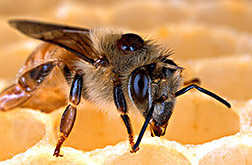This page has been archived and is being provided for reference purposes only. The page is no longer being updated, and therefore, links on the page may be invalid.
|
Read the magazine story to find out more. |
|
|
|
|
New Bait Lures Varroa Mite to its Doom
By Jan SuszkiwJuly 1, 2009
Varroa mites could literally be walking into a trap—thanks to a new attractant developed by Agricultural Research Service (ARS) scientists in Gainesville, Fla.
The 1/16-inch long parasite, Varroa destructor, is a top pest of honey bees nationwide, hindering the beneficial insects' ability to pollinate almonds, blueberries, apples, zucchini and many other flowering crops.
At the ARS Chemistry Research Unit in Gainesville, research leader Peter Teal and colleagues are testing a bait-and-kill approach using sticky boards and natural chemical attractants called semiochemicals.
In nature, Varroa mites rely on these semiochemicals to locate—and then feed on—the bloodlike hemolymph of both adult honey bees and their brood. Severe infestations can decimate an affected hive within several months—and rob the beekeeper of profits from honey or pollinating services. But in this case, the mites encounter a more heady bouquet of honey bee odors that lure the parasites away from their intended hosts and onto the sticky boards, where they starve.
In preliminary tests, 35 to 50 percent of mites dropped off the bees when exposed to the attractants. Free-roving mites found the semiochemicals even more attractive, according to Teal.
Moreover, the extra dose of semiochemicals wafting through hives didn't appear to significantly interfere with the honey bees' normal behavior or activity, added Teal who, along with postdoctoral associate Adrian Duehl and University of Florida collaborator Mark Carroll, reported the results this past January at the 2009 North American Beekeeping Conference in Reno, Nev.
The team hopes ARS' patenting of the Varroa mite attractants will encourage an industrial partner to develop the technology further.
Read more about the research in the July 2009 issue of Agricultural Research magazine.
ARS is the principal intramural scientific research agency of the U.S. Department of Agriculture.

